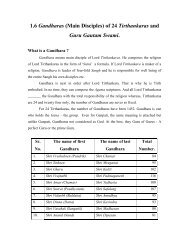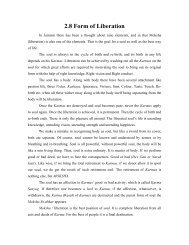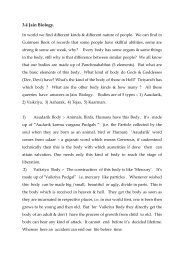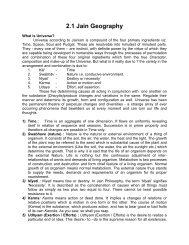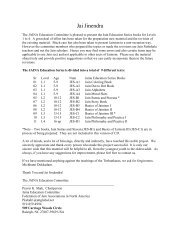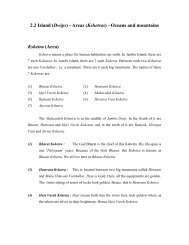âæ¢ ç¸ï¼¯ï¼ è£æ½® J - Jainism, Jain Religion - colleges
âæ¢ ç¸ï¼¯ï¼ è£æ½® J - Jainism, Jain Religion - colleges
âæ¢ ç¸ï¼¯ï¼ è£æ½® J - Jainism, Jain Religion - colleges
You also want an ePaper? Increase the reach of your titles
YUMPU automatically turns print PDFs into web optimized ePapers that Google loves.
This is the arrangement of he first enclosure.<br />
Arrangement of the Second and Third Enclosures<br />
The second enclosure is allotted to all types of animals (the five sensed ones). The third enclosure is allotted for parking of<br />
vehicles.<br />
Outside these enclosures there are crowds of animals, humans, as well as gods. Sometimes they come separately and<br />
sometimes all together. However, in spite of the crowd the movement is orderly and peaceful. There is hardly any rush or<br />
stampede or altercation.<br />
The Importance of Beholding the Samavasaran<br />
„±üü ¿¢¢Ý¢² ½±¼é J<br />
To behold the Samavasaran of a Tirthankar is such an important act that an ascetic who has not done so earlier is inspired to<br />
walk and come even if he is stationed twelve Yojan (approx.144 km) away. As it is a rule that any ascetic stationed within a<br />
distance of 144 km from the Samavasaran should come and join. One who ignores this for any reason should observe a four<br />
days fast as penitence. This is because his right perception is fret with faults of instability, shallowness and dilution.<br />
The appearances of the Tirthankar sitting in the Samavasaran is so breathtakingly beautiful that if all the gods join together<br />
and try to create that beauty in the dimension of a toe, it cannot surpass the beauty of the toe of the Tirthankar.<br />
In terms of the beauty of the form the list of people in order of descendence is as follows (The beauty of the earlier being<br />
infinitely more than the latter: Tirthankar, Ganadhar, Ascetics with normal human body, Anuttar Vaimanik gods, Navagraiveyaka,<br />
Achyut, Aaran, Pranat, Anat, Sahasrar, Mahashukra, Lantak, Brahmlok, Mahendra, Sanat Kumar, Ishan, Saudharma,<br />
Bhavanavasi, Jyotishka, Vanavyantar (all dimensions of gods), Chakravarti, Vasudev, Baldev and regional kings. The common<br />
kings and other people are further down on the scale with much larger gap. (The traditional reduction being-infinitely<br />
less in six attributes).<br />
The Acharyas have explained the purpose of this breathtaking beauty of the Tirthankar that appears due to the precipitation<br />
of the Tirthankar-karma. They say that this divine beauty of the Tirthankar inspires loose attending the Samavasaran to<br />
indulge in religious activity, all those who are earthly, beautiful ought to do so. The utterances of a divinely beautiful person are<br />
listened to with attention. The pride of the narcissists also shatters in presence of such an embodiment of pure beauty. These<br />
are the reasons that make the divine beauty of a Tirthankar praiseworthy.<br />
The Ideal of Humility<br />
Amar Muni - Tirthankar Charitra - Surana # 62<br />
jainuniversity.org<br />
The first words the Tirthankar utters when he starts his discourse are - “Salutations to the ford of religion”. After this he begins<br />
his discourse in easily understandable words of the common man’s language, Ardha-Magadhi, with the specific purpose that<br />
every one present may understand and absorb the words and their meaning. As the status of Tirthankar is gained because<br />
of the establishment of Tirth (ford of religion), salutations are first of all offered to the Tirth. The cause of becoming revered<br />
is reverential even for the revered one. The religious only in the inhabited region; the Tirthankar recognizes this fact with due<br />
reverence. Another reason is that when such a lofty and endowed person as a Tirthankar displays such humility he sets an<br />
example for others to follow.<br />
The Volume of the Speech<br />
With the advancement of technology the capacity and scope of transmission of sound with the help of amplifiers, telephones,<br />
radios and satellites has increased manifold. However, the Tirthankar’s speech is naturally endowed with unique attributes.<br />
As such in the Samavasaran the voice of the Tirthankar reaches the eardrums or hearing organs of all five sensed beings.<br />
Everyone in the audience thus removes his doubts and ambiguities.<br />
The Tirthankar gives his discourse only in one language, but the assembly has the congregation of gods, humans and<br />
animals. How do they all understand this monolingual discourse? It is something like the single color water turning into a<br />
variety of colors depending on the soul it falls on; black, white, red or grey etc. One of the unique attributes of the Tirthankar’s<br />
speech is this capacity to automatically get translated into the language of the listener. In this age of advanced technology it<br />
is nothing to be astonished about. In the United Nations Organization there are representatives from almost all nations of the<br />
world. There is a multiplicity of languages, but the technology has made it possible that any speech in any language is<br />
immediately translated into the language of the listener.<br />
There are twelve types of congregations in the Samavasaran. If the preaching of the Tirthankar does not inspire any of the<br />
listeners to take a vow of any on of the four Samayiks (a specific spiritual practice), Sarvavirati (total renunciation), Deshvirati<br />
(partial renunciation), Samyaktva (right conduct), and Shruti-Samayik (listening to the scriptures), all this effort of construction<br />
of the Samavasaran and collecting such a large crowd would go waste. But it is not so. Once the Samavasaran is created,<br />
the Tirthankar does give his discourse. For once at least, his preachings make lasting impression on the psyche of the<br />
www.jainuniversity.org







